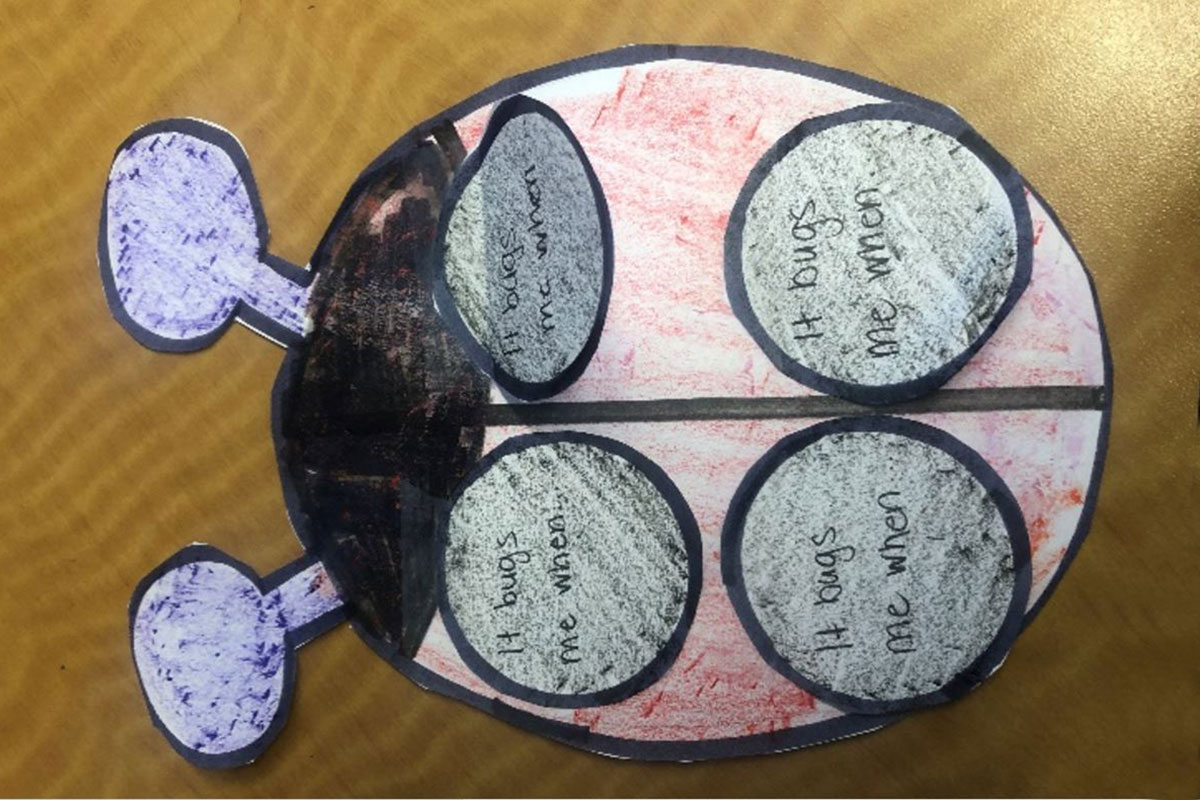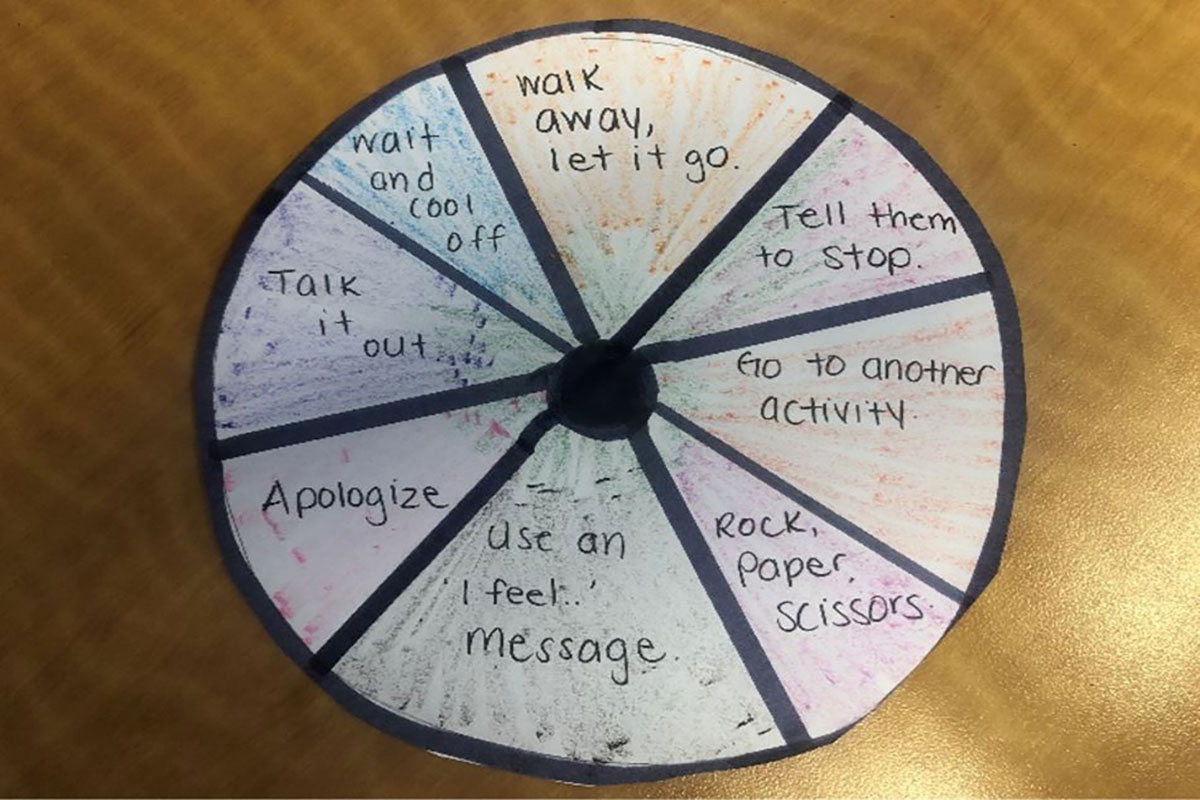Leadership - day 4 conflict management
These activities can be done alone, but work best with one or more friends on a video chat like Skype, Zoom, Facetime, etc.
Grades K-3
Grades K-3
Mindfulness Activity:
Trivia question: True or false: all caribou (reindeer) have antlers in the winter?
Mindfulness Activity:
- Walk around the room.
- Now walk slowly.
- Now walk normally.
- Now, walk VERY slowly.
- Walk normally again.
- Now, walk very, very slowly.
What Bugs Me Bug
Supplies:
- Paper
- Crayons
- Markers
- Scissors
- Glue
Watch the What Bugs Me Bug video
To deal with conflict, we need to know what things make us feel upset. If we know the different things that ‘bug’ us, we are more likely to be able to communicate our feelings and handle conflict in more appropriate ways.
- Have your child draw and cut out the shapes of a lady bug and colour them in.
- Cut out 4-5 spots and glue or tape the top portion of the spot to the lady bug so that you can flip up the spot.
- Under each spot have them write the answer to the following statement: It bugs me when...
As a family, have everyone share their "what bugs me bug". Discuss as a group some healthy ways to manage conflict.

Problem Solving Wheel – What can I do?
Supplies:
- Paper
- Crayons
- Marker
Help your child draw a conflict resolution wheel with the different coping strategies listed.
Have your child decorate the wheel and go through each section in detail. Think of examples together for the items that need more clarity.
Post the problem-solving wheel where it can be seen and refer back to it whenever they are struggling with conflict management.

Apology Stick Bouquet
Supplies:
- Collected sticks
- Ribbon
- String
- Paper
- Makers or crayons
- Glue
- Scissors
A good leader knows it is important to apologize. Some apologies can be a simple "I'm sorry", while others need extra work. It's important to recognize when you are wrong and when you need to apologize.
- Next time you go for a walk, have your child collect a handful of sticks that look interesting and/or would look nice all bunched together.
- Cut the sticks so they’re all the same length and tie them together with a nice ribbon.
- You can decorate the sticks by making paper ornaments or dipping some sticks in paint and letting them dry.
- Next time your child needs to apologize to someone, have them write an apology note, attach it to the bouquet and give it to the person they are apologizing to.
Review Questions:
Ask your chld:
- When you're in conflict, what are your biggest feelings? How can the problem-solving wheel help you with those feelings? (Feel)
- Do you think it’s important to stay calm if you’re in a conflict situation? Why or why not? (Think)
- When would you ask for help from an adult if you’re in a conflict? (Act)
Mindfulness Trivia Answer
Answer: False, only female caribou have antlers in the winter.
Grades 4-6
Grades 4-6
Mindfulness Activity:
Trivia Question: How much of the oxygen you breathe goes to your brain?
Mindfulness Activity:
- Sit down so you’re comfortable.
- Think about your favourite ice cream.
- Imagine how cold it is on your tongue.
- Imagine eating it as slowly as you want.
- Enjoy!
Inspiring Leaders
Supplies:
- Colouring items
- Cardboard or paper
- Scissors
A leader's role is to resolve conflicts and come up with solutions that will make the team happy. We all have leaders we admire and respect.
Have your child think about leadership: what makes a good leader? What makes a bad leader? What are some leadership styles? Come up with examples of good leaders.
Ask your child to choose their favourite leader and create a card about them. On one side, your child will draw their favourite leader. On the other side, it will have interesting facts or reasons why your child sees them as a good leader.
Mimes
Supplies:
- List of questions
- 2 or more people
Some conflicts happen because perceptions are not accurate. Sometimes we make judgements based on assumptions. Practice questioning and clarification with your child.
- Take turns asking questions like the ones below.
- Instead of saying the answer, the other person can only act out their answer.
- The asker can ask as many clarifying questions as they want to gain an understanding of the other person's answer.
Topic Questions
- How do you like spending your free time?
- What's your favourite game and why?
- What is your happiest memory?
- What do you want to be when you grow up and why?
- What are some things you are proud about?
- If you had a million dollars, what would you do with it?
Anything Goes
Supplies:
- 2 or more people
Discuss with your child the differences between a debate and a dialogue. A dialogue is collaborative in nature and participants are working toward shared understanding. Whereas a debate is a discussion with the goal of persuading or supporting your own view.
- Stand face to face with a 6-foot distance.
- Put your right fist out (as in Rock, Paper, Scissors) and say together, "Nothing, something, anything!"
- Once the word "anything" is said, each person yells out the name of any item they can think of (dog, coffee mug, shoe, etc.).
- Now each person debates why their item would "beat" the other person's item.
- Allow about two or three minutes of debate, then call a brief time-out. Discuss the differences between debating and dialoguing.
- This time use the same items in dialogue instead. Ask questions and listen to the answers, with the goal of coming to an agreement.
Review Questions:
Ask your child:
- How did you feel when you were debating? (Feel)
- What do you think would make you good at having a dialogue? (Think)
- What leadership skills can you use in the future to help resolve conflicts around you? (Act)
Mindfulness Trivia Answer
Answer: 15%-20%
Grades 7+
Grades 7+
Mindfulness Activity:
Trivia Question: Which country gave us the words 'shampoo' and 'pajamas'?
A) India
B) China
C) Italy
Mindfulness Activity:
- Sit down and notice your thinking.
- In your head, tell yourself to relax.
- Notice what happens next. Are there any more thoughts popping up inside your head? Are they negative or positive?
Building Your Skills
Supplies:
- Pen
- Paper
Conflict is a disagreement or clash between people, ideas or principles. Conflict is a natural and normal part of life. It challenges us to think harder and to be more creative
.
Here are 5 tips for how to respectfully disagree with people.
- Don't make it personal. If you get upset, it can help to remember you're mad at the idea or concept, not the person.
- Avoid putting down the other person's ideas and beliefs.
- Use "I" statements to communicate how you feel, what you think, and what you want or need. Using "you" statements can sound like you want to fight.
- Listen to the other point of view. Being a good listener is a way of showing respect.
- Stay calm. The most important tip, but usually the most difficult.
Practice using these tips with the ideas below. Role play with a friend or write down how you would respectfully disagree with the following statements:
- Dogs should not be pets. They are dirty, smelly and destroy everything in the house.
- Facebook is better than Tik Tok. Facebook has more people on it, more information and is user friendly.
- Fireworks should be banned in Canada. They are dangerous and hurt people.
Stress Ball
Supplies:
- 3 balloons
- Corn starch, flour or sand
- Funnel
- Scissors
During conflict, it's normal to sometimes feel upset or stressed out. What are some things that help you feel calm when you are in a conflict? Follow these instructions to make your own stress ball to squeeze when you are feeling big emotions.
- Stretch out your balloon. Blow it up and deflate the balloon a few times for some extra stretch.
- Choose your filling: sand, flour or corn starch
- Stick a funnel into the neck of the balloon.
- Slowly fill the balloon. Pour slowly to avoid clogging the neck of the balloon. If it does clog, use a pen or pencil to clear the opening.
- Remove the funnel from the balloon and let out as much air as you can.
- Tie the neck of the balloon so it's closed tightly.
- Cut off the excess rubber.
- Grab your second balloon and cut off the end.
- Grab your last balloon and cut the end, leaving enough to tie.
- Tie the end, and voila! You've made yourself a squishy stress ball.
Conflict Cartoon Strip
Supplies:
- Any size paper
- Pencil/markers/coloured pencils
Divide your paper into 4 or 8 boxes, depending on how many frames you want. Create a cartoon strip with some sort of conflict or disagreement in it.
- Use one of the tips from the Building Your Skillz activity in your cartoon strip.
- Be creative with your cartoon.
- You can make the characters animals, superheroes, friends or even celebrities.
Give your cartoon a title and make sure to sign your cartoon.
Review Questions:
- When you get into a disagreement with someone, how do you feel? (Feel)
- How do you normally try to resolve a disagreement that you have with another person? (Think)
- What will you do to change the way you deal with conflicts? (Act)
Mindfulness Trivia Answer
Answer: A) India

